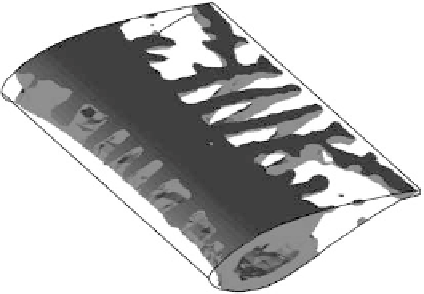Environmental Engineering Reference
In-Depth Information
•
The bandwidth that is mentioned in literature [19] is only attainable in laboratory
conditions. In applications the bandwidth is limited by the cooling rate that the
system can impose on the SMA material.
Typically, the heat that is put in, is not recovered and therefore energy loss. This
•
makes the power consumption of SMA materials relatively high as compared
to, for instance, piezoelectrics.
4 Structural layout of smart rotor blades
The most promising concept until now has been camber control and the trail-
ing edge fl ap design. The fl ow will stay attached and the boundary layer is not
disturbed by the presence or actuation of the device. The difference between
camber control and a continuously deformable trailing edge fl ap, is only in
which amount of the cord is deformable and the distinction between the two
is arbitrary.
However, in order to introduce this concept, the aft part of the cord over the part
of the span of the blade where the fl aps are to be integrated, will have to be fl exi-
ble. In current, rigid blades, usually a sandwich construction is applied in these
regions of the blade to assure the shape stability of the shell and to provide resis-
tance against buckling [105]. A thin monolithic laminate is favorable for actuation
by adaptive materials or to house a mechanism that is deformable in cordwise
direction (e.g. a compliant mechanism or Monner's “fi nger” concept).
If the design relies on the trailing edge for its edgewise properties, for instance
by the presence of UD strands there, the design will need reinforcements in sec-
tions where the trailing edge is fl exible. But these features are mainly implemented
in the outboard region of the blades. The trailing edge reinforcement, if imple-
mented, is placed in the inboard section of the blade. Another issue resulting from
the removal of slots where the actuators are placed in, is the occurrence of stress
concentrations. This can be tackled by the introduction of reinforcing elements
(e.g. ribs, additional spar) to locally strengthen the blade.
Figure 16: Topology optimization of the internal outline of a blade by Joncas
et al.
[ 106 ].

Search WWH ::

Custom Search